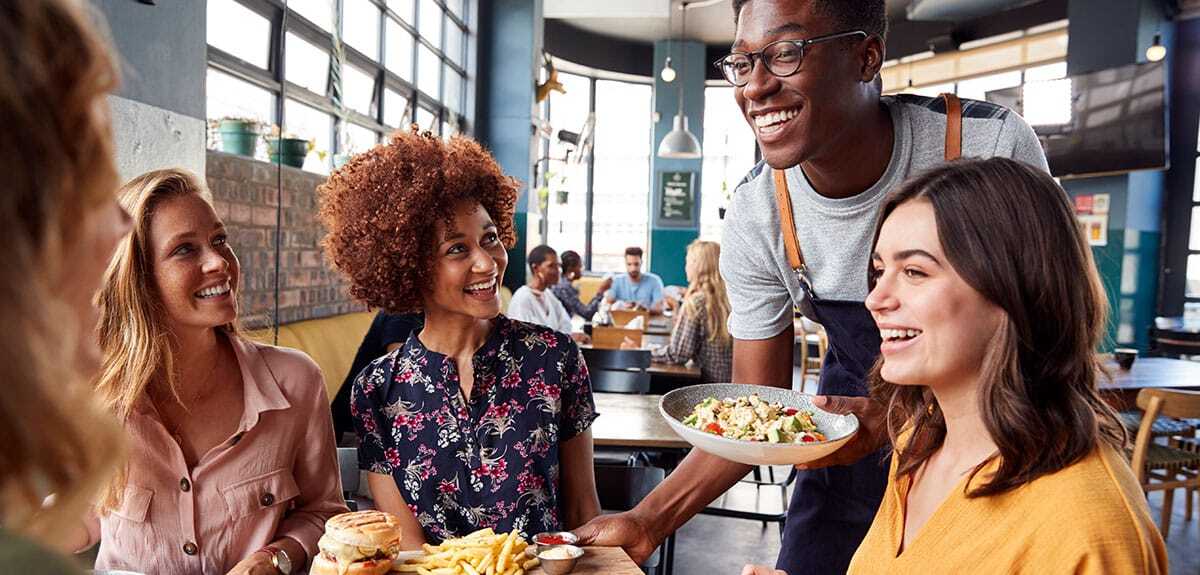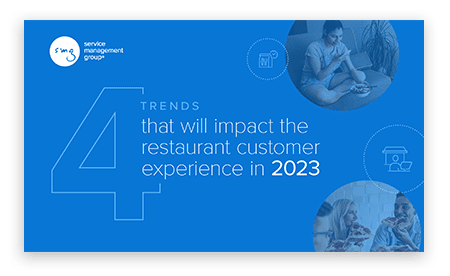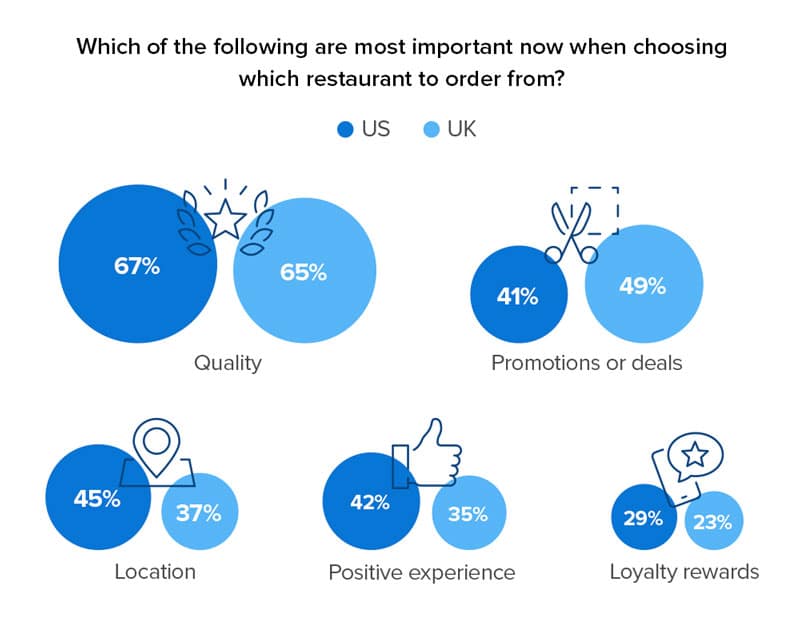Driving Brand Loyalty for Restaurants through Value-Focused Offerings
Published on Oct 19, 2022

Consumers are cutting back on spending and “value” has become the name of the game—especially for the restaurant industry, which is taking one of the biggest hits.
A recent SMG study showed nearly 70% of UK respondents (a 12-ppt increase since April) and close to 60% of US respondents plan to dine out less over the next 12 months. And when consumers do go out to eat, they’re choosing restaurants that provide a valuable experience.
But what does “value” really mean? Is it low cost? The best deal? Highest quality? To drive brand loyalty for restaurants during these volatile times, understanding what value means to customers and executing on those expectations is essential. Because when you execute on value, you are rewarded—customers who are highly satisfied with value return 3-4 days faster.
In this blog, we’ve laid out 3 steps restaurant brands should take to ensure they’re delivering the value-forward experience customers are demanding.

4 trends that will impact the restaurant customer experience in 2023
Step 1: Define what value really means to your customers
It’s easy to assume value is just a synonym for low price—which wouldn’t be great news for an industry experiencing a significant rise in food costs. But value doesn’t begin and end with a dollar amount—it’s an all-encompassing experience that determines what something is worth. This is the best way to drive brand loyalty for restaurants.

Some factors of value can vary from brand to brand (what’s valuable to a QSR customer may be different from someone visiting a fine-dining restaurant). That’s why it’s important for your brand to understand what value means to your customers.
But there are some elements that will consistently contribute to customers’ value perception. The first one is quality. Our research shows around 65% of consumers will choose a restaurant based on the quality of food served. Which means cost isn’t the most important thing, so long as you’re providing a quality product.

Next on consumers’ list is deals + promotions, location/convenience, and a previous positive experience. So again, only one of those factors is really about price. And though location isn’t really something you can control, the rest of these measures can be accomplished with the right strategy and execution—and help drive brand loyalty for your restaurant.
Step 2: Keep your brand’s value strategy on-track
Customer expectations are constantly evolving and can change overnight—especially during times of economic struggles. That’s why it’s so important for brands to have a holistic experience management (XM) strategy in place. If you’re not continuously hearing from your customers, you’re operating in the dark—and that’s not something you can afford to do with consumers tightening up their wallets.
This starts with the right customer experience (CX) program—one that captures and analyzes consumer feedback and behavioral data across all channels—from social media, to apps, to your website, to in-person—to understand customer motivations and help you meet their expectations.
But in this competitive market, restaurants also need to know where they stand as a brand. With traditional brand trackers, branded competitive benchmarks, and behavioral data and insights from millions of consumers, you can answer critical business questions and gain deeper perspective on your customer, your brand, and the market.
With access to these tools, you’ll be able to answer critical business questions like:
- Why do consumers choose my brand? What about my competitors?
- What are my consumer profiles vs. my competitors’?
- What’s my biggest strength?
- When do our competitors’ consumers choose to visit us?
- Where do consumers go when they don’t visit? Why?
- How can I convert non-customers and infrequent guests to loyalists?
Being armed with these answers will help you evolve your CX strategy so you are always current with consumer trends and behaviors. This will also give you a leg up on competitors that aren’t putting as much effort into understanding what customers want. And with a smaller visit share up for grabs, this could be the fine line between being a beloved brand vs. an irrelevant one.
Step 3: Execute value-forward initiatives that drive customer loyalty
So now you know what value means to your customers and you have a system in place to collect their real-time feedback. The next step is to put this information into action. Here are a few examples of targeted ways restaurant brands can differentiate themselves from competitors and win customer loyalty.
Think outside the box to accommodate new customer expectations
It’s not that consumers aren’t spending money—they’re just spending less of it. And if restaurants continue to operate in the way they always have, they run the risk of losing business. It’s up to brands to come up with creative ways to pivot and meet customers’ evolved demands.
Lower priced restaurants have an opportunity to wow customers who may be trading down from more expensive alternatives. Brands that can deliver higher than expected quality and a great customer experience are more likely to convert those trading down to more frequent users of their brand even after the economy improves.
Higher-end restaurants also have an opportunity to drive traffic. This can include offering lower cost menu items and offering specially bundled or paired items at a lower price to help retain those tempted to trade down. Offering lower priced items has allowed some brands to keep regular menu items and prices intact for customers with less financial concerns.
It’s also important to pay special attention to promotion-based customers and work to create an excellent experience for those customers who visit due to a value offering. Performed successfully, you can convert a promotion-driven customer into an experience-based customer and create a customer for life.
There will always be a market of consumers seeking satisfying experiences that make their lives more fulfilling. Delivering on these experiences is one way to ensure your brand survives the challenges ahead.
Offer rewards your customers care about
There are several ways you can reward customers for their business and promote return visits. Here we are going to focus on two: loyalty programs and feedback incentives.
Loyalty programs
Loyalty programs have long been a go-to tactic brands use to keep customers coming back. Whether it’s a simple punch card or a point system tracked in a branded app, giving customers a little something extra for choosing you is a great way to entice them to choose you again.
Loyalty memberships can also foster a sense of “exclusiveness” by giving members an inside track on things like special promotions, LTOs, new menu items, etc. It’s also a way to increase sales (even if they’re coming in to redeem a free item, there’s always an opportunity for upselling.)
Promoting its loyalty program paid off for Krispy Kreme Japan. When the brand launched an initiative to ramp up membership, it not only increased its loyalty program by 4X, it improved customer satisfaction on key service standards, drove a 5-ppt increase in Intent to Return, and saw a YOY sales increase.
Feedback incentives
Using incentives to solicit customer feedback does two things: 1) It ensures your experience management program provides an accurate read on your brand’s day-to-day customer experience by garnering a representative sample; and 2) It provides customers with a reason to come back.
Some common incentives include free item with purchase, BOGO, and $ off (either with a minimum purchase or without parameters).
Here’s where our clients have seen success regarding their incentive offering:
- By testing a variety of incentives across regions, an SMG client determined a higher-value free item with a minimum purchase led to stronger sales than a lower-value free item given away without a purchase.
- A QSR brand discovered when customers do return to redeem their incentive, they purchase 3 additional items on average—offsetting the cost for operators by boosting average ticket size.
Again, the trick is finding what works best for your brand. Work with your CX vendor to execute incentive best practices and determine what lands best with your customers.
Be smart about tech investments
Not too long ago, most restaurant brands didn’t put a lot of effort into their omnichannel strategy. Digital ordering was dominating the retail world, but omnichannel restaurant ordering simply wasn’t in much demand—until the pandemic accelerated the need for off-premise ordering and forced restaurants to rethink their digital offerings.
Today, mobile apps have come a long way and are a huge presence in the restaurant industry, with 3 in 4 customers reporting using app ordering to place their digital orders.
But as a KPI, total number of downloads pales in comparison to actual usage metrics. Of the 83% of consumers who have at least one QSR app installed on their phones, more than one in three had not used a restaurant app to place an order in the past 30 days.
To evolve past being a novel touchpoint, QSR apps must provide a convenient, seamless, and satisfying customer experience. But too often, brands are falling short. Today’s consumers keep running into app-related issues (e.g., limited or no customization offerings, limited menu options, glitchy tech), creating a barrier to convert downloaders into repeat users.
Brands that are able to iron out these issues and provide a more seamless digital experience will have the advantage. Our research shows mobile apps can actually be great for business and bring in incremental visits—in fact, when a customer doesn’t experience a problem from a mobile app, 25% are more likely to visit the restaurant more often.
As more brands make headlines with app-exclusive menu items and promotional campaigns, a longer term strategy focused on user experience and customer engagement metrics must be in place to ensure your digital ordering channels deliver ROI.
Stay on top of consumer trends to strengthen the customer experience
Solidifying customer loyalty is not an easy feat right now. With a more discerning eye on value, consumers are being more selective about how they spend their discretionary funds—and unfortunately, that’s having a big impact on the restaurant industry.
While this presents a bigger challenge for restaurant brands, it’s not an impossibility. Consumers are still spending money. They’re still going out to eat. Maybe less frequently and maybe with a smaller budget, but it’s happening. Brands able to pivot and provide customers with the little extra value they are seeking will be the ones to snag up a bigger piece of the visit share pie. We will continue to navigate this ebb and flow of consumer spend and keep brands aware of noteworthy changes in trends. Our most recent report, 4 trends that will impact the restaurant customer experience in 2023, is a great resource for restaurants as they iron out their CX strategy for the upcoming year. Be sure to download your complimentary copy.
Related articles

Consumer Behavior Trends: Spending Habits in 2022
As of last June, 81% of Americans owned a smartphone. In the throes of this convenience revolution—as more consumers turn to their phones for research and to make purchases—the pressure for brands to

3 ways to retain customers + create brand loyalists in a world of unlimited options
To be competitive in the current retail environment, brands must go the extra mile to earn repeat customers and gain their loyalty.

Adapting Your Customer Experience for the Digital Age
From restaurant and retail to c-store, healthcare, and every industry in between, it’s rare to find a customer experience that isn’t touched by technology. And this digital omnipresence means brands t